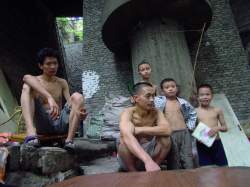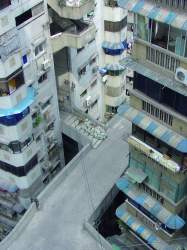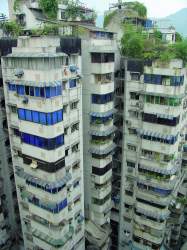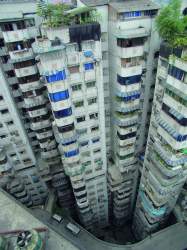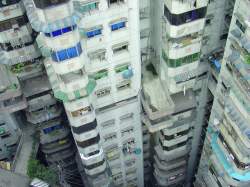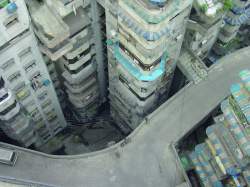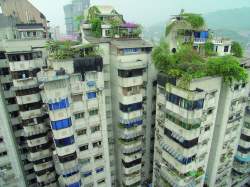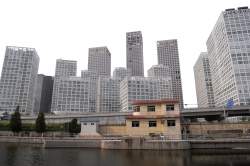Utopian Cities 乌托邦城市
Utopian Cities or How The Author Solves The Problems Of Rural China
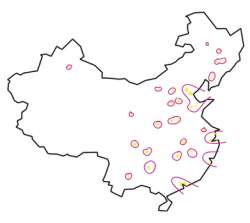
By 潘维 - Pan Wei
Free translation By Adrian Hornsby and 晓月 - Carol Xiao
中国要赶超发达国家的必经之路,是将农村的剩余劳动力安全转移:让他们脱离老式的农耕结构,进入现代的城市经济范畴。也就是说,中国政府的当务之急即是要制定出好的城市化政策。它的重要性要大大超过经济的增长幅度——实际上,这一举措是具有政治紧迫性的。
Introduction
Compared to ancient western slavery and systems of agricultural serfdom, the Chinese free-peasant economy was really quite advanced. However, 2,400 years of immobility followed by the last 100 years of haphazard industrialization and ideologically charged political reform, has brought it to a state of 21st century crisis. Its current organization may be regarded as an end point.
China fell behind other countries due to low per capita income, consequent stagnation of domestic demand, and high dependency on exports. This situation is inextricably linked to population / land mass ratios, where a field-stock of 2 billion mu 1 is expected to provide income for a rural population of 900 million people, of whom only 500 million are actively engaged in farming. The notion of “wealth growing in the field” is tied to an agricultural era; wealth production cannot advance in the context of a “one mu field economy”. As the dilapidated rural economy, with its beleaguered secondary and tertiary sectors, comes into contact with a market economy, widespread insolvency followed by political instability is inevitable.
The sole route to catching up with developed countries is to facilitate the safe rapid exodus of the rural surplus: out of archaic farmland struc-tures, into modern urban economies. Therefore the core task of the Chinese government is to produce positive urbanization policies. The importance of this goes beyond economic expediency — it is in fact an urgent political measure.
1. In which the author has an idea for rapid urbanization
It is too expensive to enlarge the old megacities. It stresses both the urban infrastructure and the ecological capacity of the surrounding area. On the other hand, the widespread building of smaller towns is land-expensive and highly pollutant. The correct peasant-destination is the megacity, but China currently suffers a lack of them.
Thus the author brings forth his bold solution: based on the principle of national macroeconomics, the population is to be redistributed such that of 1.5 billion people, 500 million are accommodated in new metropolitan areas; 500 million in existing megacities; 400 million in mid to small size cities; 100 million in rural areas. The key to achieving this is the building of sufficient megacities for a combined population of 500 million within 30 years. If each megacity holds 5 million, 100 megacities are required. Therefore if we build one new city per province every ten years across 30 provinces, the target can be substantially achieved within three cycles, or 30 years. The intellectual support for this scenario comes from 5 considerations.
1 new city per province every 10 years across 30 provinces
每省10年建1个新城,在30个省建3轮,“乡村中国”将变成“城市中国”
i. Fast urbanization through rural residential urbanization urge
Almost all developed countries had at one stage a predominantly rural population. However, there is no case beside China where rural pre-dominance is concurrent with large-scale commercial establishments; perpendicular, informed, and efficient government; widespread com-pulsory education; gross (if not excessive) industrial capacity; and the intense urge for urbanization among millions of peasants. This situa-tion can be regarded as an urbanization arrearage*. The extent of the urbanization arrear-age* and the pressure of the urbanization urge can be witnessed by current rail travel statistics: 100 million peasants take the train to the city every year.
ii. Fast urbanization through peasant potential
The revolution in China showed us that regarding the peasants as objects of charity, restriction, and limited education is not a sustainable method of government. The rural population has and will continue to play a key role in both modernization and economic growth. The peas-ants should be offered the opportunity to earn honor and pride in peacetime as much as in time of war. Denied this opportunity, in the context of a market economy, they may align themselves with rebels for the purposes of political insurrection.
iii. Fast urbanization through the building of new megacities
The fabric of the existing cities is neither so flexible nor so robust that it can withstand the target volume of peasant influx. Instead the peas-ants must be organized to build new cities for themselves. This is wholly in keeping with the glorious tradition of organizing peasants to face difficulties together.
iv. Fast urbanization through the comparative study of urban development
There are four major models for urban development in the world:
1. Europe The bulk of the rural population was steadily transformed into an urban population through industrialization, which converted peasants into factory workers.
2. Latin America Large numbers of farmers were forced into the city by latifundia reforms. Rapid growth of city slums ensued.
3. Japan Farmers served as soldiers during the long-running war and then as factory workers when they returned home.
4. USA People gathered together quickly to join / create the urban economy via self-governance, advanced city-planning, and the freedom of large volumes of deregulated land.
The US model is the most advanced and suitable for China. China however is now in a better position to embark upon mass urbanization than the US was at an equivalent stage in its history thanks to powerful economic growth, technological advancements, and the compara-tively educated labor force. Urbanization in the US was heavily reliant upon a brutal civil war and the labor and movements of poorly edu-cated recently freed African-Americans. The biggest obstacle China faces is the lack of discipline and high levels of selfishness among farm-ers, which makes them difficult to organize. Organization in this effort is critical because the Chinese environment, unlike the US, is not such that the task of building cities can be left to individual explorers and their potentially conflicting ideas. The plan has to be led by central gov-ernment, and supported by local government.
v. Fast urbanization through a policy of “farmers build cities for themselves”
Farmers are offered the opportunity to exchange their land and six years of construction labor for housing in the new city. “Farmers must have land of their own” was the basis for the peasant economy. “Workers must have houses of their own” will be the basis for the metropoli-tan society.
===2. In which the author lays out a scheme for building a new city===
The author uses Jining in Shandong as an example
i. Location and budget
The government should gather together a team of global experts to devise the irrigation and urban planning. This will result in the most ad-vanced urban design, in accordance with the saying “a piece of blank paper is the most beautiful to draw upon.” Banks should provide gov-ernment-assured loans to attract domestic and international investment, using land and tax incentives and the promise of high return as the financial bait. With the government’s announcement that it is building a New Jining for 6 million people opportunities will be created for venture capital and individual investment funds.
ii. Land requisition
The first phase of New Jining should cover an area of 200km2. This is about one third of the size of Singapore, and less than 2% of the Jining prefecture. The second phase of New Jining should bring it up to 600km2, which is about the same size as Singapore.
Land requisition from peasants will be rationalized on the basis that apartments in the future New Jining will be granted in exchange for the requisitioned land plus 6 years labor constructing the new megacity. An example may be laid out as follows: the farmland of a family of three is exchanged for one apartment in the future New Jining; the house of this family can be exchanged for a second; if both parents work for six years building the city, they will receive one more. In this fashion a local rural family stands to gain three apartments in the New Jin-ing, and thus become property owners. If in the course of building New Jining certain plots of requisitioned land are temporarily unoccupied, it will be possible for families to continue living and farming there until construction activities reach the site.
It should be noted that these numbers are purely imaginary and experts are needed to study plans carefully and convert property (farmland and future urban land) and labor into specific quantities. On the basis to these calculations it will be possible to float “New Jining apartment exchange tickets”. Crucially the land requisition itself will not require cash, in accordance with the principle “farmers build cities for them-selves”.
iii. Infrastructure
Infrastructure for the new city should be planned in advance and, starting with the drainage, be built over the first four years to cover an block 14x14km in dimension. Systems for water, gas, electricity and telecommunications should be integrated to make them clearly legible and easy to maintain in the future. The owning companies and providers should be related to and with each other. The apartment exchange market should allow the infrastructure to be built at cost.
iv. Industrial belt
Advance planning should identify an industrial area within New Jining and ensure that it is supported by related infrastructures. Work should be done at the outset of building New Jining to secure investment for the industrial belt. This will reassure rural workers concerned about employment prospects in the future city, and help maintain order throughout the construction phase.
v. Residential
Having requisitioned the land for free, the government should be in a position to apportion it to residential plots for free. Money for building materials, construction equipment, and the cost of hiring designers and engineers should be covered by the surplus building stock created (i.e. those apartments built over and above the total number required to guarantee the “apartment exchange tickets”). What if the value of this surplus building stock turns out to be insufficient for the expenses incurred? The government will need to budget carefully, and balance costs with money generated by auctioning off parts of the city centre to commercial development. Besides, even if there is an outstanding cost of say 20,000RMB on each apartment, this would constitute a total cost of only 20 billion RMB for 1 million apartments. To cover this the city government could issue “New Jining Construction Bonds”, to be paid off by future tax and administration fee revenue.
Alternatively, the government could decide to subsidize the new apartments, and spend 20 billion RMB on converting 3 million farmers into urbanites. This could prove to be one of the best subsidies ever made. The enthusiasm of millions of laborers building millions of apartments for themselves would be a powerful attractor to other businesses and individuals thinking about investing in New Jining. And for the farmer-laborers themselves, four years of building infrastructure and a further two on their own apartments would see them installed in their new homes. Within ten years there would be a powerful and successful city, built by them, and belonging to them.
4 years building infrastructure plus 2 years on apartments sees the farmer-laborers installed in their new urban homes
花4年建基础设施、2年建住宅,农民就又建了新城又有了新居
vi. Labor sources
But where will these millions of laborers come from? The total number of farmers on land directly requisitioned for the building of New Jining will not provide the required workforce. A province-wide effort will be needed across Shandong to encourage poor farmers from other areas to participate in the construction of New Jining. A system can be implemented by which any rural couple from Shandong can work for six years on city-build projects in return for an apartment. An additional condition requires them to hand over their farmland and former houses in the villages upon receiving a key and residency card for New Jining. These plots of land can then be sold by the government, thus recuperating money paid out to farmers when they left the village for transport and living expenses during the six years of building. From the point of view of a poor farmer, six years of building can be rationalized against six years of dead-end farming, the difference being that by the former they walk away with an apartment in a megacity. The scheme would be a fascinating one to embark upon, and with the assurance of six years of employment, would certainly beat hanging around in the village and gambling all the time.
It would also be possible for entrepreneurs to come during the building work and set up ventures of higher profit — for example, providing services to the millions of construction workers. These entrepreneurs would be potential customers for the higher-end residential market, thus helping to finance the cost of building materials.
vii. Labor force organization
Even though the central theory of the fast urbanization plan is “farmers build cities for themselves”, its realization requires the government to involve itself in the organization of the labor force. The scale and complexity of the task would be sufficient to weed out incompetent officials by a process of natural selection.
Worker groups should be organized along the lines of former towns or townships, villages, and farmer groups, with each group led by officials originating from the same regions. This system has five major advantages:
1. Easy to manage
2. Easy to distribute provisions
3. Easy to merge farmland freed up in the former villages
4. Easy for future city administration
5. Easy to educate those rural workers in their natural groups and help prepare them for becoming city residents
At this point the author senses a potential problem in the building of New Jining: if the farmer-laborers do not like the conditions of the new city, they may want to return their apartment, and go back to their former life in the fields. This will be addressed shortly.
viii. Education
The experience of being organized into productive teams which build a new city and create wealth is already part of the education process for former semi-employed or unemployed rural dwellers. However, the construction site of New Jining should also be a university. Laborers will be expected to work forty hour weeks, in addition to which will be “night school for workers”. This will be laid on by the government with a teaching staff made up of professors, officials, students and volunteers. Over the six years, courses will be offered which provide workers with the knowledge and necessary training to become lawyers, economists, civil engineers, doctors, forensic investigators, social scientists, restaurateurs, interior designers, and experts in world affairs.
New Jining should also be a university.
The Party should also provide some military and security training, as well as holding a wide range of cultural and sporting events. There should be regular competitions with the chance to win honor or receive punishment, with prizes available for the best workers. The most efficient laborers and organizers should have top priority when it comes to choosing apartments.
ix. Impact on economic growth
济宁新城的建设工地应当成为一所农民大学
Creating organized labor forces creates production. Excellent administration enhances productivity. Efficient production in a stable context generates wealth. Each new megacity in China should make a significant contribution to GDP, not to mention improvements to the domestic human resource through training and skills. Further benefits to the national economy would come on three fronts.
1. The first consideration is the economy of those villages left behind by the new urbanites of New Jining. Those who remained as farmers would find that the availability of farmland, food production, and income all increased several fold. The demolition of the former homes and plots of three million former farmers, and the subsequent operation of land amalgamation and rationalization, would allow the rural condition to benefit from modern economies of scale. Thus the currently underperforming countryside will be converted into a well-managed productive sector.
2. The building of the New Jining megacity would require enormous volumes of materials — not only cement, steel and power, but also materials for every aspect of modern urban life, and the machinery and technologies behind them. Textiles, plastics, electronics, engines and parts, and a wealth of knowledge will all be needed. The effort required to provide these things will give industry and business in general a terrific boost.
3. China would develop a larger role in the global market of resource distribution, which is an important part of the strategy for long-term development. At present China has an excess of foreign currency savings, but lacks metal mines. Through the building of new cities we would bring large quantities of key metals into China, thus gaining a significant future resource.
3. In which the author explains urbaniza-tion and considers the economic feasibility of his new city by answering three elemental questions
Every city that has ever existed started with the gathering of people, and the building of their homes. When making plans for the creation of a successful city, it is necessary to consider three elemental questions:
1. Why do people come to the city? (Should they come?)
2. What will people do there? (Will there be things for them to do?)
3. How does need become surplus — i.e. how does a group of people in need of wealth, resources etc., become a group of people with a surfeit of wealth, resources etc.? (Can need become surplus in this city?)
The author will now address these questions in relation to his proposal for New Jining.
QUESTION 1. Why would three million peasants come to New Jining in Shandong province?
ANSWER 1. To improve their quality of life
To understand this answer it is necessary to ask one further question: what does “improving your quality of life” actually mean? Human beings have three basic urges: the urge for food, for reproduction, and for shelter. Within the context of urban planning, to improve living conditions is to improve housing conditions and income, as the combination of wealth and high quality housing has the power to address these three urges. Generally the areas with the best housing offer the best quality of life, and house the richest people. For most Chinese citizens, owning a home of some kind will be the most significant piece of capital they acquire. Therefore the quality of that home is instru-mental to any assessment of their wealth or the quality of their lives.
Thus the success of New Jining is contingent upon the promise of better quality housing, viz. a toilet, running hot and cold potable water, decent heating and insulation etc. Current living conditions in much of the Chinese countryside are comparatively basic, but the residents themselves represent a labor force with considerable building experience (from both local and migrant work), industrial experience (from TVEs* work), and a minimum of nine years education. Couple this to the CCP’s strong organizational capacity, and the potential to mobilize these residents and set them to building high quality housing stock becomes an almost tangible near-reality. The very nature of that stock will then ensure Shandong-wide metrophilia.
QUESTION 2. What would three million peasants do in New Jining?
ANSWER 2. All the things a young dynamic city needs them to do.
The employment situation for the peasants of Shandong is very poor. Families on small plots of farmland work for maybe three months a year, producing barely enough to feed themselves. Beyond this, time is spent playing cards, board games and gossiping. There are those who work longer in the fields, pulling out grass by hand at the end of every day, but ultimately benefit little for all their pain and effort. In the meantime, writers pass through and give dolorous accounts of village life, describing parents who cannot even afford paper for the education of their children. Often nothing is done in the village because there is nothing worth doing. The villagers cannot improve their situation by, for example, building a road, as the government will not finance roads to such tiny destinations. And besides, what of worth could be trans-ported in or out? The demand itself is too impoverished to warrant infrastructure, and thus a stone is laid over further development or em-ployment prospects.
Often nothing is done in the village because there is nothing worth doing.
农民贫困是因为无“事”可做,村里没有“值得”他们做的事
This situation of limiting the opportunities and usefulness of work is disastrous as it is work itself which creates wealth. The impetus to work is maintained by high levels of demand. In New Jining, the building of the city alone would provide six years of continuous employment, effecting the creation of enormous wealth and a population of property owners. The outlook from there is that there would be a new city with new demands, resulting in contracts and dependencies on a scale unthinkable when its population was still dispersed among innumerable indigent villages. A thriving tertiary sector, previously inexistent, would spring up. Production would follow demand, and at the same time demand further production. Refocusing the economy from exports to the nurturing of internal demand would recirculate wealth. It is a common fallacy that the economy leads, and shapes cities, when in fact it is the people and cities which come first, and stimulate economic growth.
There are of course instances of failed urbanization, where people have come together in cities and created only unemployment and social instability. This is notable in Latin America. However, the proposal for New Jining distinguishes itself from the Latin American paradigm in three ways:
1. The urban poor of Latin America own no property, lack education, suffer from bad organization and feeble discipline, and subsist within structures of poor social order with a consequently weak investment climate. The fact that this is the case often in spite of rich physical re-sources only goes to demonstrate how little physical resources have to do with the creation of wealth. On the other hand, the residents of New Jining would own their own apartments, benefit from a minimum of nine years compulsory education plus a further six years of construction site night-school, would be hard-working, literate and strong-willed, and serried within a rigorous social structure comparable to that of Japan or Singapore.
2. The citizens of New Jining would be first generation migrants coming from situations of poverty and unemployment. With this back-ground they would not be picky about jobs but, like the post-war Japanese, would be willing to work hard at anything.
3. The scientific urban design of New Jining with its comprehensive plan for the accommodation of migrants (often sorrily lacking in new towns in developing countries) would provide a city with excellent infrastructure and a plentiful supply of cheap labor. Such conditions are highly attractive to investors, offering the combination of logistical efficiency and an energetic labor market.
QUESTION 3. Without “money”, how does job demand become job availability? How does so much need turn into so much boom?
ANSWER 3. Labor and wealth are not the product of currency — currency is an expression of demand met by production.
Currency is used for measurement, exchange, savings and investments, and loans, but in all of these instances is serving merely as a representation of either work done or work to be done. It has no intrinsic substance or power. The only absolute requirement for the production of money is a group of workers, and if a city can provide this, it can invent its own wealth.
Having built New Jining, its inhabitants could then mortgage their apartments (thus realizing work done) and use the capital to invest in new ventures of their own, as well as consuming the products of the ventures of others. The process of building a city is itself a way of storing up an immense volume of work done, and thus wealth. The fact that the city then has needs is the first principle of its subsequent economy: the needs can be treated as demand; demand in the presence of facilitated workers creates production; the meeting of demands with production runs off as wealth. The concept of a city is in fact synonymous with the conversion of need into boom. A city is simply a way to gather demands, and the capacity to meet those demands via work, into a single location.
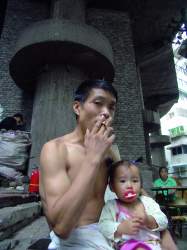
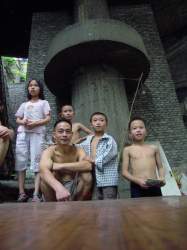
The concept of a city is in fact synonymous with the conversion of need into boom.
城市的概念就是将“需求”转化为“兴旺发达”
4. In which the author brings his arguments to conclusion
Well organized collective work is the foundation for modern society. This is true whether the organization is done chiefly by the state, as under communism, or by bodies operating within a market. New cities will be the best place for China to organize its workers, and it is in this direction that development should proceed. But the author has higher hopes for New Jining than mere economic growth. Developing new cities will also create many crises, the solution of which will bring forward outstanding leaders. These leaders will be able to go on and mold new systems of government, which will allow New Jining to become one of the “best inhabited environments” in the world.
Twenty-four centuries ago the “Shangyang Reform” set up the free peasant-economy, and established the foundation for a united rural China. China has now reached a new turning point — in terms of its economy, the lifestyles of its people, and of Chinese society itself. Rapid urbanization provides the torque for this change. Offering rural residents the framework to build their own cities gives change to the people; the people in turn change the nation.
Note
1.Chinese unit of area: 1 mu is equivalent to 666.6m2. 2 billion mu is approximately 1.3 million km2.
Glossary
urban arrearage a situation where the developmental level of the economy, of the commercial & industrial sectors, of the sophistica-tion of the government, and of the public education system all outstrip the level of urbanization.
Chinese version below/中文版如下
组织贫困农民建设新的大型城市
——解决我国农村问题的一条思路
潘维
序言
比起西方古代的奴隶农业和中世纪的农奴农业,我国的自由小农经济是先进的。小农经济在工业时代遇到了严重危机,成就了二十世纪的中国革命。在经历了百年痛苦的改良实验之后,自由小农经济走到了其2400年历史的尽头,绝无挽回的余地了。
我国经济落后于他国的主要原因是人均收入低,市场内需不足,所以经济发展严重依赖对外贸易。这个困境来自一个基本现状:5亿人从事农业,9亿农村人口,9亿人从20亿亩耕地里找饭吃。地里“生长”财富与“制造”财富,性质完全不同,前者属于农业经济时代,后者属于工业经济时代。
在村庄的“一亩地经济”里,人均收入上不去是必然的,内需不足,工业“生产过剩”,第三产业不发达也是必然的。一旦遭遇市场机制,这种带有自然经济色彩的小农经济不堪一击,必然出现乡村破败,社会衰退,经济破产,政治动荡。
让大多数农村人迅速而且安全地离开耕地,离开农业,从而扩大内需,是我国经济赶上发达国家的唯一希望。因此,抓住主要矛盾,推行积极的城市化政策,是我国宏观经济领域的核心任务。城市化还是一项紧迫的政治任务:如果工农联盟是计划经济的基础,那么,在市场经济条件下,迅速消灭城乡差别是我国社会团结和政治稳定的基础。
一.高速推进城市化的思路
扩建大型旧城的代价明显太高昂了。遍地开花兴建小城镇,则占地多,污染面广,经济上站不住脚。农民们要去的是大城市。中国缺少的也是大城市。
作者提出了一个高速推进城市化的大胆方案。以国家的宏观经济政策为杠杆,用30年时间使我国15亿人中的5亿生活在新的大都会,5亿生活在已有的大都会,4亿生活在中小城市,1亿生活在乡村。实现这个计划的关键是,在30年里建成能容纳5亿人口的大型新城。若一个新城容纳500万人口,约需100个新城。在30个省里,若每省每10年兴建1个新城,经过3轮总共30年的建设,“乡村中国”将被彻底改造为“城市中国”。
1.高速城市化方案的前提是我国农民强烈的城市化冲动。
几乎每个今天的发达国家都经历过70%的人过农牧业生活的时代。但在同一发展阶段,世界上没有任何国家拥有我国这么强大的工商业基础设施、垂直有效的中央政府、义务教育普及程度、惊人的“过剩”工业生产能力,以及亿万农工的城市化冲动。只要注意每年春运期间在铁路上盲动的亿万农工,就知道我国欠了多少“城市账”。
2.高速城市化方案的依靠对象是贫苦农民。
我国革命的历史经验说明,把农民看成救济、启蒙、甚至限制的对象,就不可能发掘我国农民伟大的创造力。看不起农民,我国革命不可能成功。排斥农民,我国建设事业也不可能成功,我国就永远是“发展中国家”。农民是我国现代化的主力军,是城市化的主力军,是中国经济持续高速增长的发动机。如同战争年代,和平年代的政府也要给贫苦农民挣来尊严和荣誉的机会。否则,他们在市场时代会成为造反者的同盟军。
3.高速城市化方案的主要思路是以建大型新城为主攻方向。
扩建旧城的代价已经太高了,而且无法容纳等待进城的大量农村人,甚至无法容纳我国的新增人口。依靠中央、省、和基层政权的组织力量,把农民组织起来,就能不依赖政府财政,建设新的大城市。应当继承我党组织农民的光荣传统,不能在困难面前退缩,不能放弃组织农民,领导农民的传统政策。
4.高速城市化方案的学术基础是对城市发展道路的比较研究。
世界上有四种主要的城市化模式。(1)欧洲模式,通过漫长的工业化逐渐减少小农,使他们成为工人阶级。(2)拉美模式,通过大庄园的土地集中把农民挤压为城市贫民。(3)日本模式,通过长期的对外战争把农民变成士兵,然后成为工人。(4)美国模式,通过城市自治和先进的城市规划,给城市扩张的自由,迅速把人们聚集在一起,制造城市经济效应。我国比较适合美国模式,但与美国不同,中国城市化的条件比美国强得多。美国建城时既缺少资本,又缺少技术,特别是缺少人力,可说是一穷二白,空手建城。美国的城市化甚至靠残酷的内战,解放完全没受过教育的黑奴。我国最大的缺陷是农民散漫自私,很难组织,而且不存在美国靠冒险家个人来组织城建的大环境。因此,我国的城市化靠政府主导,依赖基层政权。
5.高速城市化方案的原则是“农民的城市农民建,建好城市为农民”。
即农民家庭以耕地、房基地权利,以及6年的劳动换取大型新城的住房。“耕者有其田”是我国小农社会的基石,劳动者有其屋是我国城市社会的基石。
二.新建大型城市的操作方案
以山东济宁地区为假想范例,作者为建设大型新城设计了一个操作方案。
1.新城选址规划和预算。
应当由政府来组织世界上最优秀的专家集团来进行水源论证和城市规划,务求拥有世界上最先进的城市规划。“一张白纸,好画最新、最美的蓝图”。建新城的预算原则是:银行提供由国家出面担保的建设贷款,以省和中央政府的辅助性财政支出为饵,努力吸引国内和国际的民间资本。当国家宣布“新济宁”600万人口的大都会规划,民间游资就有了机会和出路,自然有民间资本与银行一道进行风险投资。
2.新城征地。
济宁新城近期规划征地200平方公里,约为新加坡面积的三分之一,不到济宁辖区面积的2%。远期规划600平方公里,与新加坡面积相同。征地原则是土地加劳力置换楼房。笔者提出下述操作设想:1户(3口人)耕地可置换未来新城的1套楼房住宅;一户(3口人)的房基地权利可再置换1套;如果夫妇两人为新城建设免工资劳作6年,还可再获1套。6年里,这户当地农民夫妇能获得济宁新城的3套住房,成为小房产主。征后暂时不用的耕地和房基地由农民依旧耕种和居住,直至新城建设需要占用为止。当然,这些置换数字只是设想,专家则要精确折算,折成不动产和劳动的量化标准,按量化的标准发放“新济宁住宅交换券”。如此,政府征地所几乎不需要现金。正所谓:农民的城市农民建,建好城市为农民。
3.新城基础设施。
新城基础设施建设以4年为期,首先是在14公里长,14公里宽的规划区里铺设巨大的城市给排水管网络系统。这种大型水泥管将成为上下水、电力、通讯等管线一劳永逸的地下共用走廊,也方便维修更换。同时大量铺设井字形的城市道路,使城市能够开放、扩张。沿路种植树木,并把为拓宽道路的预留地铺设成建筑工程车辆使用的道路。购买上述基础设施原料的资金,部分来自银行贷款,部分来自出售未来的工业、商业、文化设施用地。电讯、电力、水力、煤气等管线设施则是有关上市公司的长线投资,谁建谁拥有。建设基础设施所需的劳力以未来的居民住房偿还。所以,基础设施的成本主要是原材料。
4.新城工业区基础设施。
工业区的规划和基础设施建设是城市规划和城市基础设施建设的一部分,也是由免工资的农村劳工来建设的。工业区的招商引资工作是在兴建住宅区之际,市政府开始正常运转之时才开始。新城政府的主要工作是在国内外宣传新城,招商引资。对新城的政府而言,解决新城就业问题是头等大事,其意义在于让城市的建设者能稳定地在自己的城市中生活。
5.新城建设百万套住房。
原则上,农民不用出钱购买住宅建材。城市用地是政府几乎无偿征用的,给农民的住宅用地当然也是免费划拨的。建筑设计图纸由政府提供。购买建筑材料、租用施工机械、支付工程师工资等项开支,由出售、甚至预售建成的多余住宅款支付,比如规划一定比例的住宅供出售。没有土地成本,没有房地产公司的利润,没有建筑工人的工资支出,建设简单住宅的花费基本上只是建材。或许,出售多余住宅的钱仍然不够购买建材。如何解决呢?政府要精打细算,比如尽量使用本地生产的建材,拍卖市中心土地。把居民区建在市核心商业区以外,为金融、商业和装有电梯的高层昂贵住宅预留市中心土地。如果实在无法弥补的住房建材成本是2万元一套,100万套也才200亿元。银行贷款给新济宁,或者市政府发行“新济宁建设债券”,用将来的工商税收和市政管理费偿还,也是不错的办法。一座数百万人口的城市,200亿元债务不算多。如果政府要补贴农民,把补贴农业的钱转移到补贴农民建设居民房的建材上效益更好。若政府一次性支出200亿元,建设至少能居住300万人的城市住宅,让300万农村人进城,拥有大城市住房,就非常合算,是效益最高的“扶贫款”了。在一片空地上,百万民工们为自己建设百万套楼房住宅,每人建1 套,50人建一栋,最多需要2年。民工们的劳动热情会怎样?同他们今天在城里工地上打工一样,没人负担他们的吃穿住行、医疗、子女教育。然而,给资本家打工和给自己打工是不一样的。他们不出1分钱,用自己的劳动建设自家的住房。他们先用4年建设基础设施,再用2年建设自己的住宅,6年即可入住。有个10年光景,一座新城就会出个漂亮模样,那不仅是他们自己建造的,而且属于他们自己。
6.新城劳动者的来源。
在建设基础设施和百万套住宅的6年里,工人们从哪里来?被征地的“原地地主”当然没有百万。山东省要号召本省最贫困地区的农民参加新济宁的建设。任何一对山东省的农民夫妇,只要免工资劳动6年,都可以得到济宁新城的一套住房,成为新城的房主。但附加的代价是,在得到住房钥匙那天,该户农民必须将三口人的责任田退还给本省当地的农村集体,并放弃该户在原居住地的房基地权利(房屋则可自行折价出售),落籍于新济宁。省政府或可规定,签约参加新济宁建设的本省外来劳工,其家乡的农村集体适当发给迁移补助(退还房基地和耕地的补偿),主要用于补贴6年内民工建设新城的伙食开支。原则上,百万劳工6年的伙食自理,是变相的“自带干粮”,因为自家的土地还在由自家人耕种。在六年里,民工吃的粮,名义上是自种自食,本质上已经转化为商品粮。放弃家乡的耕地和住房,工作6年,在一个巨大的都市里换回一套甚至数套住房,成为这个城市的主人,这个计划对贫苦农民是很有吸引力的。那是6年的工作保证,比蹲在家里没事干,天天赌博强得多。比起济宁新城原来的“地主”,来自本省其他地区的劳工必须付出更多,因为被征地的农民碰巧占有“地利”,仅凭每户的耕地和房基地就能置换两套住房。一部分原来的“地主”可能不愿参加以劳务换取更多住房的计划,而是去从事利润更高的工作了,比如为百万建设大军提供各种有偿服务。他们可能是购买济宁新城“好区多余住房”的重要客户,为建设住房的原料出资。
7.新城劳动者的组织。
对于建设新济宁城,政府的财政责任很小,主要负组织责任,建设济宁新城需要政府去组织劳工。尽管“农民的城市农民建,建好城市为农民”,缺少了政府的组织,新济宁城根本就不会出现。在繁重的组织工作里,企图当官做老爷的官员,缺少组织能力的官员,自然会被淘汰。省政府要让干部带队,组织农民尽量成建制地(基于原有的乡镇、村、组)加入以工作换楼房的城建计划。应当鼓励农民以村为建制,以村党支部、团支部为核心,组成建筑工程队来参加济宁新城的建设。这样做有五大好处:(1)方便工程建设的组织管理;(2)方便民工伙食管理;(3)方便民工家乡将来成片还耕房基地、重划耕地,合并村庄;(4)方便将来的城市管理;(5)方便把“农民工”培训成市民的任务。同时,作者预见到新城经济挫折的可能性。新居民如果不满意济宁新城的经济条件,可以依照预签的工作合同,放弃济宁新城的住房所有权,退掉自己的换房券,在农村易地换回相当面积的耕地使用权和房基地权,重归小农生活。
8.新城劳动者的教育。
把原本处于半失业状态的贫苦农民组织起来,用劳动创造财富,建设新家园,建设大城市,这本身就是教育小农的有效手段。济宁新城的建设工地应当成为一所农民大学。建设工地实行8小时5天工作制。政府要组织教师、官员和大学生志愿者开办“民工夜校”。民工夜校“学制”6年,组织农民接受各种工商技能的培训,并讲授法律、经济、交通、卫生、地理、城市生活、家居装修、市民精神,世界事务、等等方面的知识。同时,党团机构还要组织民兵和保安训练、各种文艺体育活动、各种技能竞赛,制定工伤补偿和奖惩规则,定期评选劳动模范。工作特别出色者,比如优秀的组织者,技术创新者,劳动积极肯干的人,将获得挑选住房的优先权,或取得更多“住宅交换券”,从而得到较大的住房。原则上,建设新济宁的组织者们要占领民工们的全部业余时间,让他们在建设自己新家园、新生活的过程中从农民转换成市民。
9.新城将拉动经济持续高速增长。
出色的组织管理创造生产力。第一,济宁新城建设6年之后,山东民工们的家乡会发生什么?留在家乡的农民会发现:人均耕地面积成倍提高,商品粮的比例成倍提高,人均农业收入成倍提高,现金收入大幅度增加。百万套新济宁住宅里住有300万山东原来的农村人,他们因济宁新城的出现而退掉耕地和房基地,旧住宅就要推倒还耕,原有乡镇必须合并,农民还要建设新村、新居。提高我国的粮食商品化,建设农村新村,都属于新城建设效应。山东农村的内需由此扩大,不会再有所谓“三农”问题。在新城建设的高潮中,农民盲动于我国铁路“春运”的现象也会大幅度减少。第二,我国的工业经济会发生什么?济宁新城建设和百万建设大军会拉动一大批有关吃穿住行的基本产业部门。从事最原始纺织业的妇女也会有工作,比如生产劳动服装,劳保用品。机械生产部门也能恢复生产,比如重型机械和运输工具的制造,建筑材料的开发。大批的相关工业和商业会发达起来。第三,我国在世界的资源分配中将占有较大份额,这是有深远战略意义的。钢铁和水泥生产是我国经济的长项,而有色金属资源贫乏和外汇储备过多是我国的大麻烦。通过建设新城,我国将大量进口短缺的金属原料和能源,让全世界的战略原料流入我国。第四,新城建设的最重要成果是:一大批农民受到工业技能的训练,提高了我国的人口素质,迅速扩大我国拥有的“人力资本”。
三.论新城的经济可行性
世界上所有的城市都从建设住房开始。作者通过回答三个疑问来解释城市化原理,解释大型新城的经济可行性。
====1.山东300万农村人为什么来新济宁?====
答案是,他们来改善生活。
(1)什么是“改善生活”?改善生活主要体现为改善居住条件。除了延续种族的本能,吃、住、行是“生活”的基本内容。如果视我国20亿亩耕地的产出为常量,改善居住条件就是改善生活的基本内容。改善了居住条件,才能改善“行”的质量,也才能改善“吃”的质量。因此,改善住房条件是增加财富的最基本途径。一般而言,哪个国家的住房条件最好,哪个国家的生活质量就最高,那里的人民也就最富裕。对老百姓而言,住房是一生能拥有的最大宗财富。
(2)怎么是“改善居住条件”?改善居住条件的基本途径是迁移到居住条件比较好的地方去,在那里拥有住房。什么是“居住条件比较好”的地方?城市与乡村有个门槛,代表“质”的差异。人的聚居达到一定的规模就叫“城市”,就在本质上区别于“乡村”。聚居规模的“门槛”在哪里?数量的差异无法说明问题,千人为村,万人为镇,十万人为城,不能表达城乡质的差别。城乡之间的门槛是:有了一定的人口聚居规模,才可能修建“城市基础设施”。正是“现代城市基础设施”及其附属产品,比如抽水马桶、小汽车、达到饮用标准的自来水,等等,导致城市的居住条件比乡村好。极少数富人在人迹罕至的地方建设豪宅,依旧享受水电煤气交通的方便。那是他们花了不寻常数量的钱才修建起来的,而那些钱是从人口密集聚居的大城市里赚来的。石油大亨的钱,看上去是从沙漠里挖出来的金子,其实是人口密集的大城市才使汽油成为金子。今天太原高楼里普通人的居住条件,强于昔日乔家大院主人的居住条件,尽管乔家是当年山西省最富有的人之一。无论乔家多么富有,他修不起飞机场、煤气管道、电话局、大型医院、高速公路、甚至修不起自来水厂和冲水厕所。其实,因为有了“城”,乔家财富来源的“票号”才成为必要。所以,对“乡下人”而言,改善生活首先是改善居住条件,改善居住条件的最简单办法是迁居到城市,从“乡下人”变成常住城里的“城里人”,在城市拥有自己的住房。
(3)我国今天的情形是:现有的城市太少,基础设施已经“饱和”,扩建的开支已经过于昂贵,而且严重缺水,不能再为数以亿计企图迁徙来的乡下人提供拥有城市住房的机会,提供较好的生活了,甚至暂时不能再允许乡下人迁移进来。怎么办?民工们为北京建设住房,工资低得不可思议,还可能被欺骗、赖帐,干一整年都拿不到工钱,只解决一日三餐,却还依然在源源不绝地涌入。
(4)在这样的条件下,山东的农民怎样改善自己的生活?看到每年“春运”期间在铁路网上盲动的亿万“农工”,除了建设新的大型城市,还有什么别的答案吗?出于历史原因,我国建城的速度属于世界上最慢的一类,城市化比例在世界上最低,所以,人均收入也属世界上最少。我国建新城的“帐”欠得太多了,使中国农民患上了世界上最强烈的城市饥渴症。危机孕育了采用非常手段,迅速建设大型新城的可能性和机会。耕者有其田,劳动者有其屋,一旦出台用乡村的耕地、房基地和劳动力来换取未来大型新城市楼房的政策,农民加入换房计划的热情会像井喷一样爆发,重现一个浪漫火热的时代。与50年代不同,我国今天的农民有建城市楼房的能力、经验,有80-90年代在乡镇企业工作的经历,有9年义务教育的知识基础。而且,与50年代末不同,我国农业有巨大规模的过剩劳力;我国的工业有巨大的“过剩”生产能力,呼唤着扩大内需,独立自主,不再依赖发达国家苛刻的市场。最重要的是,我国的共产党政府拥有动员农民的丰富经验和强大组织手段,能够组织农民快速建设新的大都市。
为什么山东300万农民会来新济宁?那里在建设大型新城市,为他们迅速拥有大城市住房提供机会,能够在本质上改善他们的生活。如果政府组织他们劳动,他们有能力为自己建设大型的新城。
2.山东300万农村人在新济宁做什么?
答案是:他们做300万人口规模的城市“需要做”的一切工作,新城的崛起创造出了这些工作。
(1)新济宁的百万民工原本就没工作。在自家3口人的3亩耕地上,他们一年最多“工作”三个月,那“工作”还只不过是从土里刨食,喂饱自己和家人。没有这百万农民,那些耕地的产出不会变,甚至可能更多。所以,在一年里他们有9个月的日常“工作”是打牌、赌博、闲聊天。还有人在辛勤地 “做无用功”:为了多生产区区几斤粮食,天天用手去拔自家那三亩地里的草。城里的文学家们描述他们的生活有多悲惨,连孩子上学用的纸笔都买不起。但文学家们不懂,劳动创造财富,不劳动就没有财富。农民贫困是因为无“事”可做,村里没有“值得”他们做的事。他们“需要”道路,可那村庄稀疏的人口“不值得”修建昂贵的道路,他们因此“没能力”去修建道路。花费很高的代价为他们修好了公路,他们没有货物要运进运出,也就没有机动车。换言之,农村经济没有城市基础设施的“需求”,当然就没有“工作”。
(2)新济宁城有什么事需要300万民工来做?劳动是一切财富的源泉。通过劳动去创造财富的动力从哪里来?是“需求”带来的。需求导致劳动,劳动创造财富。首先,一座全新的大城市在济宁拔地而起,需要百万劳工,为山东的上百万农村劳动力提供了6年的工作岗位,还为他们提供了自有的百万套城市住宅。这件事的经济意义已经足够重大了。其次,聚居规模创造密集的交往,创造相互依赖,创造无数围绕吃穿住行的、从本质上完全不同于乡村的新需求。新济宁300万人的一切需求都是新城创造的。当这城市有了百万套住宅,300万原来的农村人住了进去,“新型需求”将成几何级数往上攀升。在现代经济结构里,第三产业一般占到40%以上,公用事业占10%以上。没有大型城市,第三产业不可能发达,提供公共产品的生产也不太经济。当中国城市化水平在世界上垫底,第三产业就落后,人均产值在世界上也就垫底,工业生产能力就出现荒唐的“过剩”。大型城市催生第三产业,催生提供公共产品的经济,也消化工业生产能力,支撑进一步的工业生产发展。人们以为先有经济项目,后有城市。其实是先有人,先有城市,再后来才有众多的工业项目和工作。因此,城市短缺是中国经济落后的基本原因。有了聚居规模,就创造需求。有了需求就“值得”去生产。生产创造更多的生产需求。无论济宁新城的人做什么,换来足够食粮的能力绰绰有余。
(3)既然连我们现有的旧城都充斥失业人口,缺少工业基础的新济宁会不会成为创造失业大军的据点,成为像拉美城市那样的社会火药库?当然不会。第一,拉美城市贫民是无产者,是缺少9年义务教育的、无组织无纪律的懒散贫民。在那里,虽然资源丰富,却连社会基本秩序都没有,投资环境相当恶劣。新济宁的300万居民是由党和政府组织起来的有产者。他们是勤劳勇敢,能写会算,有恒产、有恒心的市民。多数劳动者拥有9年义务教育的知识基础,还经历过6年的夜校培训,有严密的社会组织,与新加坡和日本相似。第二,旧城居民是从就业变成失业,而济宁新城的居民是从无业变成至少部分就业,从没有现金的人变成有现金的人。第三,旧城中相当一部分人失业,原因不是没活干,而是只干“好活”,不干“赖活”。济宁新城的居民刚刚从无业农民变为城里人,没有就业心理障碍,愿意干任何脏活累活。像刚从战争废墟里爬出来的日本人,他们愿意做任何能换回食品的工作。第四,新城规划科学合理、基础设施完备、土地和劳动力便宜,比旧城更容易吸引工商业投资者。第五,在300万有产者聚居的城市,需求是全新的、全面的、巨大的,对任何生产厂商都有极大吸引力。有需求就有生产,有生产就有工作。新济宁人需要小汽车,小汽车厂会就近装配。新济宁人需要绿化,苗圃培育产业就会兴旺发达。正因为上述道理,工业化时期先进的欧洲旧城充满失业,充满阶级斗争,而落后的美洲新城价格低廉、生机勃勃,社会祥和。正因为上述道理,当香港、上海等旧城死气沉沉,深圳新城在一夜之间便成为制造业的中心,成为华南创造就业的中心。
山东300万人在新济宁这座大城里做什么?他们此前是小农,原本就没工作。新济宁建设本身为他们提供了6年的工作。他们苦干6年,为自己建设一座新的大城,然后去做那个300万人口的城市需要做的一切事情。毫无疑问,新城市的经济会遇到困难,但没有困难,哪里会有伟大的城市?“罗马不是一天建成的”。新济宁城并不是10年就完成了,还要艰苦奋斗若干个10年,才能成为牢固的经济中心,从300万人扩张成600万人的大城,并形成本城的特色经济。
3.没有“钱”,工作需要怎么能变成工作岗位?
答案是:不是先有货币后有劳动和财富;相反,是先有需求,后有生产,然后才有货币。市场的发达和钱的“万能”让人们经常忘记共和国前30年走过的路,忘记关于“钱”的基本道理,忘记了纸币和国家银行的来源。
(1)什么是货币?劳动创造财富,货币只是交换财富(和劳动)的媒介。这种媒介的功能主要是四类:计量、交换、储存、和迟付(借贷)。
(2)济宁新城里的钱从何而来?每个新济宁人都来自货币经济,心中对劳动创造的财富都有一把货币尺子。因此,货币的四大功能原本就可以被“代金券”和简单帐簿代替。满足城市需求的生产活动带来什么?带来交换劳动的需要,带来“计工券”或者“代金券”,带来高利贷者,从而方便生产和生产者之间的交换。其实,“住宅交换券”本质上就是这样的一种“货币”,必然在市场上流通。
(3)没有货币能创造财富吗?我们共和国的历史证明,不仅资本能创造财富,没有资本也能创造财富。但是,不劳动,哪怕是有钱也不能创造财富。只有劳动,才能为我们数亿处于半失业状态的农民带来富裕。在没有多少货币的条件下,新济宁的居民,被政府组织起来,创造了一笔巨大的核心财富。每户的住房都属于一个300万人口的大都市,在入住的那一天就已经大幅升值了。
(4)货币怎样来到新城?如果是市场的原始阶段,建设新济宁的时候,特别是大城居民区建成以后,高利贷者就会来,带来全国流通的货币,满足居民储存和迟付(借贷)的需求。但是,我国已经拥有发达的商品市场和现代金融体系。在高利贷者到来之前,国家银行就已经介入了,为居民提供货币。济宁百万套住宅的每一套都能在银行抵押出数以万元计国家发行的纸币,用于投资和消费。
(5)生产厂家会来济宁落户吗?新济宁完备的工业基础设施,还有居民的数量和手里的现金,使国内外一切期待在这座大城里销售他们产品的厂家眼红,吸引他们来此就近投资设厂。新济宁的投资环境是非常好的。那是有严格纪律和良好秩序的城市,那里的劳动者有中国农民勤劳工作的悠久传统,有9年义务教育的知识基础,有6年工地夜校的技能培训,有6年严守纪律、团结奋斗建设家园的光荣历史。他们是严密组织起来的市民,而且属于世界上质量最高,价格最低的那类城市劳动大军。当日本的士兵们回到了一片废墟的祖国,他们已经是世界上最出色的市民了,所以日本成为工业生产的热土。
没有“钱”,工作需要怎么会成为工作“岗位”?有了住房就有了更多的需求,就有了更多的生产,就有了货币和银行,为经济进一步扩张提供条件。
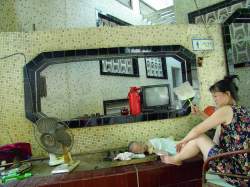
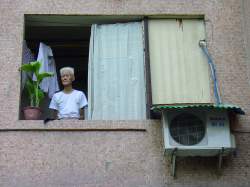
结论
劳动创造财富。严密组织起来的群体劳动,是一切现代社会的前提。现代财富的根本是建设城市,建设城市住房,让大家聚居在一起,让现代的规模经济发挥效益,让“制造”的产品取代“养殖”的产品成为经济生活的主体。作者对新济宁还有更高的期待。新城的建设和发展将经历无数的危机和曲折,克服这些危机的曲折道路将催生有大智慧的出色领导者,塑造新型的政府管理体制,把新济宁建设成世界上“最适合人类居住的”大城之一。
24个世纪以前,“商鞅变法”固定了自由小农的生存方式,奠定了中国大一统的历史基础,创造了庞大的乡村中国。后世将记住,21世纪初的高速城市化战略是中华民族生存方式的伟大转折点。把农民组织起来,变乡村中国为城市中国,过程必定极其艰难曲折,却是功在中华民族千秋万代的英雄事业。
(2004年4月15日)
(此为原载于《战略与管理》2004年第2期的简写稿)
Owned by neville mars / Added by Stephanie Yao / 17.8 years ago / 125150 hits / 37 minutes view time
Tags
Latest Entries
-
chongqing
-
utopian cities
-
city-network
-
Urban China 2020
-
The Rise of the Phoenix Panda: as reported by Erich W. Schienke
Contribute
Login to post an entry to this node.
